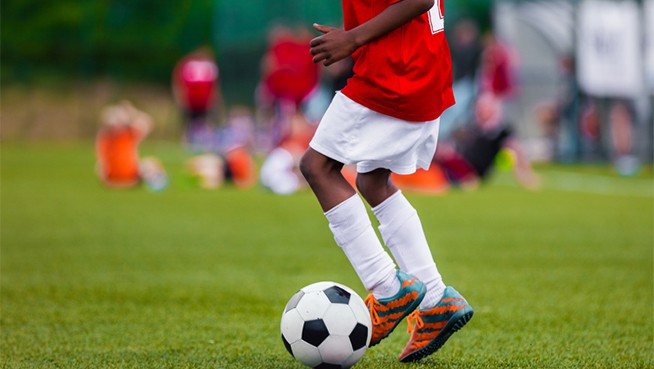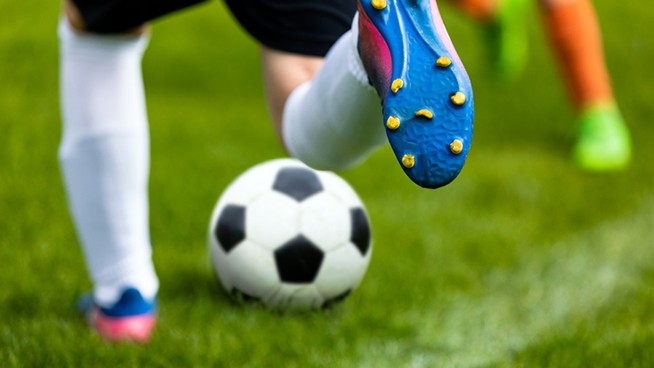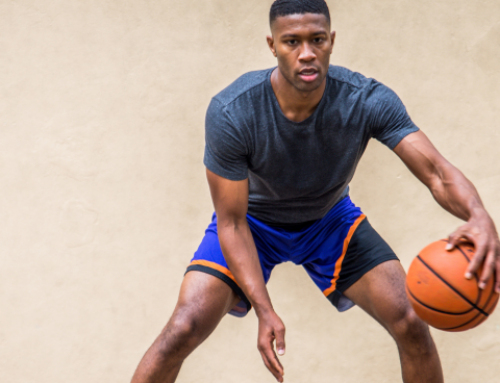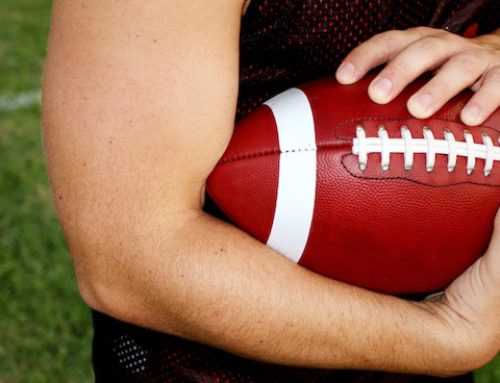5 Basketball Dribbling Techniques That Give You Untouchable Handles
All ball handlers need to be able to create space from the defense. The following five basic dribble moves will help you alleviate pressure from the defense and be poised and confident to make good decisions with the basketball.
The fundamental ways to create space are as follows:
- Change your direction.
- Change your speed.
- Use the retreat dribble.
The checklists that accompany the five dribble maneuvers will help you understand each one.
Basketball Dribbling Technique #1: Hesitation
The hesitation dribble is most commonly used when you are quickly advancing the basketball up the floor in transition and your defender is stationary or backpedaling. Review the following checklist for the correct order of operations when executing the hesitation dribble.
Hesitation Dribble Checklist
1. Speed dribble at the defense.
2. Come to a sudden stutter-brake stop.
3. Remain in your stance.
4. Keep your dribble to the outside of your body, not in front.
5. Shield the basketball with your non-dribbling hand.
6. Take your eyes to the rim.
7. Pause.
8. Explode past the defense with a hesitation dribble (see image below).
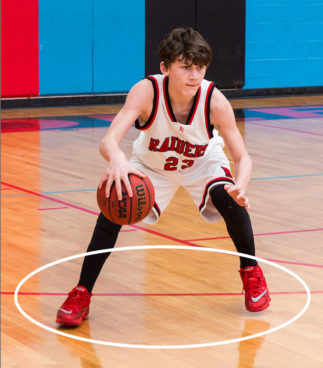
Notice that the player’s feet are chopping.
Basketball Dribbling Technique #2: Retreat
The retreat dribble is most commonly used to create space against an overly aggressive defender who is putting tremendous pressure on the ball handler. Review the following checklist for the correct order of operations when executing the retreat dribble.
Retreat Dribble Checklist
1. Enter a defensive dribble stance with your body between the defender and the basketball.
2. Point your inside shoulder to the defender’s chest.
3. Keep your chin on your inside shoulder to maintain your view of the court.
4. Pound your dribble low and tight behind your back foot (see image below).
5. Take two retreat slide dribbles back.
6. Square your body to the defense and survey your options.
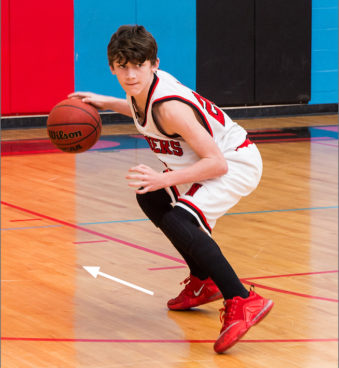
Basketball Dribbling Technique #3: Crossover
The crossover dribble is most commonly used when you are advancing the basketball up the court and the defender cuts off your angle. The crossover dribble can be a vulnerable because changing hands in front of the body directly exposes the basketball to the defense. It’s important to use the crossover only when there is at least an arm’s length of space between you and the nearest defender. Review the following checklist for the correct order of operations when executing a crossover dribble.
Crossover Dribble Checklist
1. Keep the dribble low and tight on the outside of your knee (see image A below).
2. Cross the basketball low and below the knees to the opposite hand (see image B below).
3. Cross the basketball long from outside one knee to the other.
4. Use your non-dribbling hand to shield the basketball (See image C below).
5. Put your weight on your inside foot and explode past the defense.
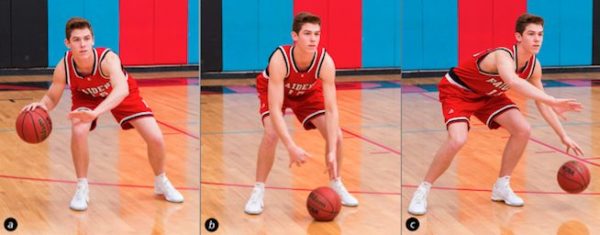
Basketball Dribbling Technique #4: Between the Legs
The between-the-legs dribble is another move that is commonly used in advancing the basketball up the court when the defender cuts off your angle. Unlike the crossover, the between-the-legs dribble can be used even when the defender is close, because your body serves as a shield as the basketball changes hands between your legs. Review the following checklist for the correct order of operations when executing the between-the-legs dribble.
Between-the-Legs Dribble Checklist
1. Keep the dribble low and tight on the outside of your knee (see image A below).
2. Stop, sit, and split your feet.
3. Cross the basketball low and tight between your legs (see image B below).
4. Use your non-dribbling hand to shield the basketball.
5. Put your weight on your inside foot and explode past the defense.
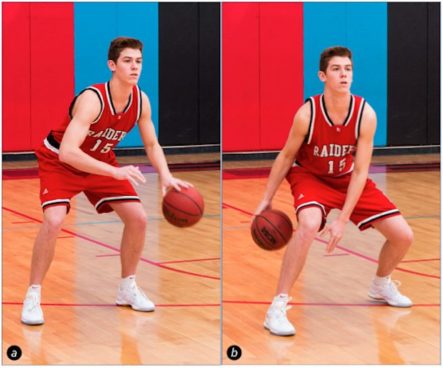
Basketball Dribbling Technique #5: Behind the Back
The behind-the-back dribble is another move that is commonly used in advancing the basketball up the court when the defender cuts off your angle. The behind-the-back dribble can be used when the defender is close, because your body serves as a barrier as the basketball changes hands behind your back. Review the following checklist for the correct order of operations when executing a behind-the-back dribble.
Behind-the-Back Dribble Checklist
1. Keep the dribble low and tight on the outside of your knee (see image A below).
2. Cross the basketball low and tight behind your back to the opposite hand (see image B below).
3. Use your non-dribbling hand to shield the basketball.
4. Put your weight on your inside foot and explode past the defense.
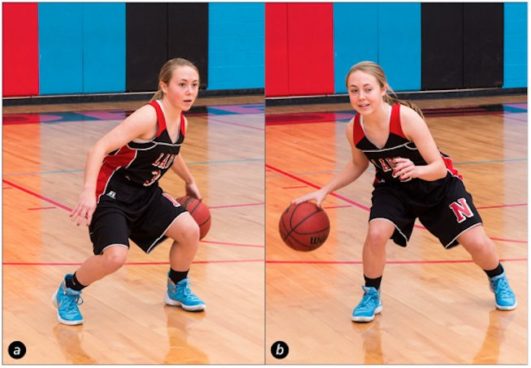
How to Improve Your Handles on the Move
This is a terrific drill to reinforce correct reads and reactions as a ball handler. In a game, there is not always enough time to think; players must build instinctual habits in practice that enable them to react.
Setup
- Use one player, one basketball and two cones.
- The player starts at half-court with the basketball.
- The coach begins at the top of the key in the middle of two cones, as shown in the diagram.
Execution
1. The player attacks the outside of either cone with a speed dribble.
2. At the line of the cone, if the coach does not move and cut off the player, the player continues in the same direction for a layup or a jump shot.
3. If the coach does slide and cut off the player at the line of the cone, the player makes a quick read and reaction and changes direction, attacking the middle of the cones for a jump shot or a layup.
4. The player repeats the drill using the crossover, between-the-legs, and behind-the-back dribbles.
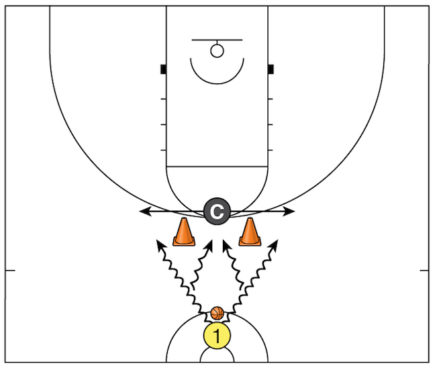
RECOMMENDED FOR YOU
MOST POPULAR
5 Basketball Dribbling Techniques That Give You Untouchable Handles
All ball handlers need to be able to create space from the defense. The following five basic dribble moves will help you alleviate pressure from the defense and be poised and confident to make good decisions with the basketball.
The fundamental ways to create space are as follows:
- Change your direction.
- Change your speed.
- Use the retreat dribble.
The checklists that accompany the five dribble maneuvers will help you understand each one.
Basketball Dribbling Technique #1: Hesitation
The hesitation dribble is most commonly used when you are quickly advancing the basketball up the floor in transition and your defender is stationary or backpedaling. Review the following checklist for the correct order of operations when executing the hesitation dribble.
Hesitation Dribble Checklist
1. Speed dribble at the defense.
2. Come to a sudden stutter-brake stop.
3. Remain in your stance.
4. Keep your dribble to the outside of your body, not in front.
5. Shield the basketball with your non-dribbling hand.
6. Take your eyes to the rim.
7. Pause.
8. Explode past the defense with a hesitation dribble (see image below).

Notice that the player’s feet are chopping.
Basketball Dribbling Technique #2: Retreat
The retreat dribble is most commonly used to create space against an overly aggressive defender who is putting tremendous pressure on the ball handler. Review the following checklist for the correct order of operations when executing the retreat dribble.
Retreat Dribble Checklist
1. Enter a defensive dribble stance with your body between the defender and the basketball.
2. Point your inside shoulder to the defender’s chest.
3. Keep your chin on your inside shoulder to maintain your view of the court.
4. Pound your dribble low and tight behind your back foot (see image below).
5. Take two retreat slide dribbles back.
6. Square your body to the defense and survey your options.

Basketball Dribbling Technique #3: Crossover
The crossover dribble is most commonly used when you are advancing the basketball up the court and the defender cuts off your angle. The crossover dribble can be a vulnerable because changing hands in front of the body directly exposes the basketball to the defense. It’s important to use the crossover only when there is at least an arm’s length of space between you and the nearest defender. Review the following checklist for the correct order of operations when executing a crossover dribble.
Crossover Dribble Checklist
1. Keep the dribble low and tight on the outside of your knee (see image A below).
2. Cross the basketball low and below the knees to the opposite hand (see image B below).
3. Cross the basketball long from outside one knee to the other.
4. Use your non-dribbling hand to shield the basketball (See image C below).
5. Put your weight on your inside foot and explode past the defense.

Basketball Dribbling Technique #4: Between the Legs
The between-the-legs dribble is another move that is commonly used in advancing the basketball up the court when the defender cuts off your angle. Unlike the crossover, the between-the-legs dribble can be used even when the defender is close, because your body serves as a shield as the basketball changes hands between your legs. Review the following checklist for the correct order of operations when executing the between-the-legs dribble.
Between-the-Legs Dribble Checklist
1. Keep the dribble low and tight on the outside of your knee (see image A below).
2. Stop, sit, and split your feet.
3. Cross the basketball low and tight between your legs (see image B below).
4. Use your non-dribbling hand to shield the basketball.
5. Put your weight on your inside foot and explode past the defense.

Basketball Dribbling Technique #5: Behind the Back
The behind-the-back dribble is another move that is commonly used in advancing the basketball up the court when the defender cuts off your angle. The behind-the-back dribble can be used when the defender is close, because your body serves as a barrier as the basketball changes hands behind your back. Review the following checklist for the correct order of operations when executing a behind-the-back dribble.
Behind-the-Back Dribble Checklist
1. Keep the dribble low and tight on the outside of your knee (see image A below).
2. Cross the basketball low and tight behind your back to the opposite hand (see image B below).
3. Use your non-dribbling hand to shield the basketball.
4. Put your weight on your inside foot and explode past the defense.

How to Improve Your Handles on the Move
This is a terrific drill to reinforce correct reads and reactions as a ball handler. In a game, there is not always enough time to think; players must build instinctual habits in practice that enable them to react.
Setup
- Use one player, one basketball and two cones.
- The player starts at half-court with the basketball.
- The coach begins at the top of the key in the middle of two cones, as shown in the diagram.
Execution
1. The player attacks the outside of either cone with a speed dribble.
2. At the line of the cone, if the coach does not move and cut off the player, the player continues in the same direction for a layup or a jump shot.
3. If the coach does slide and cut off the player at the line of the cone, the player makes a quick read and reaction and changes direction, attacking the middle of the cones for a jump shot or a layup.
4. The player repeats the drill using the crossover, between-the-legs, and behind-the-back dribbles.


